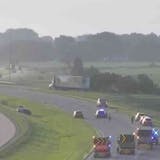Top law enforcement officials from across the metro area warned that the difficulty of attracting and keeping new police officers is reaching "crisis" proportions, a worrisome trend that one chief likened to the nursing shortage sweeping the country over the past few years.
The cautionary views emerged as the Minnesota Chiefs of Police Association met to discuss strategies to recruit and retain cops amid a flourishing economy and a marked shift in public attitudes toward the profession.
"Quite frankly we are at a point of crisis, in terms of public safety, and men and women joining this very honorable profession," said Minneapolis Police Chief Medaria Arradondo, comparing it to the nursing industry's aging workforce, which has seen vacancy rates soar as baby boomers reach retirement and many younger nurses leave the field out of frustration. He said that fewer women were applying to the Police Department than in years past, a trend that was also present in the city's burgeoning Latino population.
In efforts to step up recruitment, the chiefs association launched a six-month public relations campaign dubbed "Wear the Badge," touting the community service aspect of police work through a series of videos and advertisements on its website and outlets like School Space Media, which streams high school sporting events. The campaign's website also contains research and other resources for people interested in going into policing.
It comes at a time when law enforcement agencies large and small are struggling with a shortage of officers nationally. Officials blame the shortage on low pay, high turnover and unflattering news coverage in the wake of high-profile police shootings. According to the Bureau of Labor Statistics, the median pay for police officers and detectives nationally is $62,960. In Minnesota, the average yearly salary is $64,700 for police officers and sheriff's deputies, while detectives and front line supervisors make about $87,970.
Recently released data from the Minnesota Peace Officer Standards and Training Board shows the number of people taking the statewide peace officer licensing exam has fallen to 764 in 2018, which puts it on pace to be the lowest total in at least a decade. Fewer applicants also are passing the test, although the rate of licensure has remained stable, the data show.
In a report released this year, the Bureau of Justice Statistics found that the number of police officers nationally has largely failed to keep up with the growing U.S. population. Researchers found that while the number of sworn officers increased by 52,000 between 1997 and 2016, the rate of officers per 1,000 citizens decreased by 11 percent.
Bloomington Police Chief Jeff Potts couldn't offer an explanation for the shortage but warned that it's not warranted by less crime.



